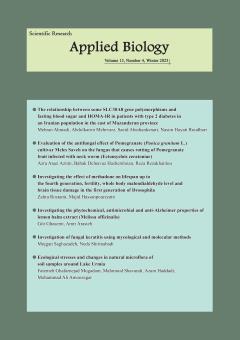Ecological stresses and changes in natural microflora of soil samples around Lake Urmia
Subject Areas : microbiology
Fatemeh Ghafarneghad
1
,
Mahmood Shavandi
2
*
![]() ,
Azam Haddadi
3
,
Mohammad Ali Amoozegar
4
,
Azam Haddadi
3
,
Mohammad Ali Amoozegar
4
1 - PhD student, Department of Microbiology, Faculty of Basic Sciences, Karaj Branch, Islamic Azad University, Karaj, Iran
2 - Ph.D., Ecological and environmental pollution control studies, National Oil Industry Research Institute, Tehran, Iran
3 - Ph.D., Department of Microbiology, Faculty of Basic Sciences, Karaj Branch, Islamic Azad University, Karaj, Iran
4 - Ph.D., Faculty of Microbiology, University of Tehran, Tehran, Iran
Keywords: Climate changes, Ecological stresses, Lake Urmia, Natural microflora, Soil.,
Abstract :
Objective: Lake Urmia, after experiencing rapid volume growth over the past few years, almost dried up in the fall of 2023. Consecutive droughts, agricultural water consumption and dam construction on the rivers feeding Lake Urmia play a significant role in reducing its water volume. In this regard, the aim of the present study is to investigate the microbiological changes created as a result of ecological changes in the highly saline lake of Urmia, which is one of the extreme regions inside Iran.
Materials and methods: The required samples were obtained from Qalgachi area, which is located near Lake Urmia. In this research, by using the usual methods of culture, purification, biochemical and microbiological tests, four microbial species were identified and classified by PCR.
Findings: Among the four microbial species selected in this research, two species (KULC3, KULC4) were salt-loving and the other two (KULC1, KULC5) belonged to different non-salt-loving species, which probably represent changes in the salt-loving microflora of Lake Urmia.
Conclusion: The occurrence of ecological changes in extreme and closed environments such as Lake Urmia, causes the possibility of microbiological changes in line with environmental changes. The results of this research showed that the microorganisms that live as natural flora in a certain area are able to adapt to the new ecological conditions and harmonize with the new environmental conditions.
1. Xu H, Wang Y, Guan H, Shi T & Hu X. Detecting ecological changes with a remote sensing based ecological index (RSEI) produced time series and change vector analysis. Remote Sensing. 2019; 11(20): 2345.
2. Hazen EL, Abrahms B, Brodie S, Carroll G, Jacox MG, Savoca MS & et al. Marine top predators as climate and ecosystem sentinels. Frontiers in Ecology and the Environment. 2019; 17(10): 565-74.
3. Turner MG, Calder WJ, Cumming GS, Hughes TP, Jentsch A, LaDeau SL & Carpenter SR. Climate change, ecosystems and abrupt change: science priorities. Philosophical Transactions of the Royal Society B. 2020; 375(1794).
4. Weiskopf SR, Rubenstein MA, Crozier LG, Gaichas S, Griffis R, Halofsky JE & et al. Climate change effects on biodiversity, ecosystems, ecosystem services, and natural resource management in the United States. Science of the Total Environment. 2020; 733: 137782.
5. Díaz S, Settele J, Brondízio E, Ngo H, Guèze M, Agard J & Zayas C. Summary for policymakers of the global assessment report on biodiversity and ecosystem services of the Intergovernmental Science-Policy Platform on Biodiversity and Ecosystem Services. Intergovernmental Science-Policy Platform on Biodiversity and Ecosystem Services. 2020.
6. Beever EA, Hall LE, Varner J, Loosen AE, Dunham JB, Gahl MK & et al. Behavioral flexibility as a mechanism for coping with climate change. Frontiers in Ecology and the Environment. 2017; 15(6): 299-308.
7. Breeggemann JJ, Kaemingk MA, DeBates TJ, Paukert CP, Krause JR, Letvin AP & et al. Potential direct and indirect effects of climate change on a shallow natural lake fish assemblage. Ecology of Freshwater Fish. 2016; 25(3): 487-99.
8. Malhi Y, Franklin J, Seddon N, Solan M, Turner MG, Field CB & Knowlton N. Climate change and ecosystems: threats, opportunities and solutions. Philosophical Transactions of the Royal Society B. 2020; 375(1794).
9. Patowary R & Deka H. Paenibacillus. In: Beneficial Microbes in Agro-Ecology (pp. 339-361). Academic Press; 2020.
10. Guan Y, Li Z, Kang Y-H & Lee M-K. Isolation, Characterization and Whole-Genome Analysis of Paenibacillus andongensis sp. nov. from Korean Soil. Journal of Microbiology and Biotechnology. 2023; 33(6): 753.
11. Deng Y, Sun Y, Wang H, Yu L-Y & Zhang Y-Q. Roseomonas harenae sp. nov., from desert gravel soil. International Journal of Systematic and Evolutionary Microbiology. 2020; 70(11): 5711-6.
12. Zhang D, Zhu Z, Li Y, Li X, Guan Z & Zheng J. Comparative genomics of Exiguobacterium reveals what makes a cosmopolitan bacterium. Msystems. 2021; 6(4): 10-1128.
13. Singh NK, Raichand R, Kaur I, Kaur C, Pareek S & Mayilraj S. Exiguobacterium himgiriensis sp. nov. a novel member of the genus Exiguobacterium, isolated from the Indian Himalayas. Antonie Van Leeuwenhoek. 2013; 103: 789-96.
14. Mujere N & Moyce W. Climate change impacts on surface water quality. In: Hydrology and water resource management: Breakthroughs in research and practice (pp. 97-115). IGI Global; 2018.
15. Li F, Huang Y, Hu W, Li Z, Wang Q, Huang S & et al. Roseomonas coralli sp. nov., a heavy metal resistant bacterium isolated from coral. International Journal of Systematic and Evolutionary Microbiology. 2021; 71(2): 004624.

